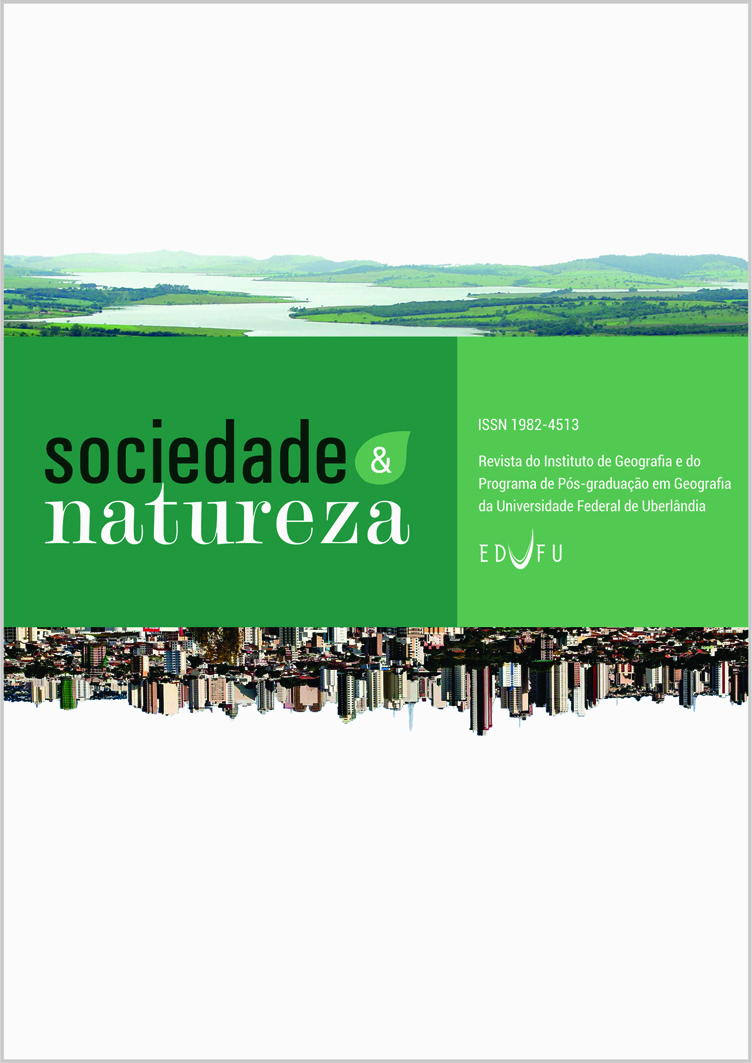Abstract
Characterized by reciprocal influences with artistic practices, creative geographies intend to explore innovative methodologies in Cultural Geography’s field. The article has the objective of unravelling the ways by which the creative (re)turn in Geography can potentialize research practices for the contemporary geographer. In order to do so, bibliographical research and revision was employed alongside an approach with Merleau-Ponty’s existentialist phenomenology philosophical provocations. It has comprehended that the different ways of making and writing Geography in the context of its creative turn can bring new reaches to its study field. Innovations on research divulgation and ways of approaching subjects/objects are an important motivation to possibilities in the development of geographical science. It is concluded that creative geographies are more than a passing tendency and can be a foundational route for contemporary Cultural Geography innovations.
References
ALMEIDA, M. G. A propósito do Trato do Invisível, do Intangível e do discurso na Geografia Cultural. Revista da ANPEGE, v. 9, n. 11, p. 41-50, 2013. https://doi.org/10.5418/RA2013.0911.0004
BAUCH, N. A Scapelore manifesto: Creative geographical practice in a Mythless Age. GeoHumanities, v.1, n.1, 2015, p.1-21. https://doi.org/10.1080/2373566X.2015.1069716
BIEMANN, U. Counter-geographies in the Sahara. In: DEAR, M.; Et. Al. (Orgs.) Geohumanities: Art, history, text at the edge of place. London: Routledge, 2011, p.162-172.
BRADY, E. Aesthetic regard for nature in Environmental and Land Art. In: HAWKINS, H.; STRAUGHAN, E. (Orgs) Geographical Aesthetics: Imagining space, staging encounters. Ashgate: Surrey, 2015, p.197-210.
CASEY, E. Earth-Mapping: artists reshaping landscape. Minneapolis: University of Minnesota Press, 2005.
COUPER, P. R. The embodied spatialities of being in nature: encountering the nature/culture binary in green/blue space. Cultural Geographies, v.25, n.2, p.285-299, 2018. https://doi.org/10.1177/1474474017732978
CRESSWELL, T. Geographies of poetry/poetries of geography. Cultural Geographies, v.21, n.1, p.141-146, 2014. https://doi.org/10.1177/1474474012466117
CRESSWELL, T. Towards Topopoetics: Space, place and the poem. In: JANZ, B. B. (Org.) Place, space and hermeneutics. Cham: Springer, 2017, p.319-332. https://doi.org/10.1007/978-3-319-52214-2_23
DUFOURCQ, A. Merleau-Ponty : Une ontologie de l’imaginaire. New York: Springer, 2012. https://doi.org/10.1007/978-94-007-1975-0
ESHUN, G.; MADGE, C. Poetic world-writing in a pluriversal world: a provocation to the creative (re)turn in geography. Social & Cultural Geography. V.7, n. 3, p.1-9, 2016.
GRATÃO, L. H. B. Por entre becos & versos – a poética da cidade vi(vi)da de Cora Coralina. IN: MARANDOLA JR, E.; GRATÃO, L. H. B. (Orgs.) Geografia e Literatura: ensaios sobre geograficidade, poética e imaginação. Londrina: EDUEL, 2010, pp.297-328.
HAWKINS, H. Dialogues and Doings: Sketching the Relationships between Geography and Art. Geography compass. V. 5, n.7, p.464-478, 2011. https://doi.org/10.1111/j.1749-8198.2011.00429.x
HAWKINS, H. Geography and art. An Expanding field: Site, the body and practice. Progress in human geography. V.37, n. 1, p.52-71, 2012. https://doi.org/10.1177/0309132512442865
HAWKINS, H. For creative Geographies: Geography, Visual Arts and the Making of Worlds. Routledge: London, 2014. https://doi.org/10.1177/1474474014530961
HAWKINS, H. Creative geographic methods: knowing, representing, intervening: on composing place and page. Cultural Geographies, v.22, n.2, p.247-268, 2015. https://doi.org/10.1177/1474474015569995
HAWKINS, H.; STRAUGHAN, E. Geographical Aesthetics: Imagining space, staging encounters. Ashgate: Surrey, 2015. https://doi.org/10.4324/9781315584355
KAUSHIK, R. Art and Institution: Aesthetics in the Late Works of Merleau-Ponty. London: Continuum International Publishing Group, 2011.
LÉVY, B. L’empreinte et le déchiffrement : géopoétique et géographie humaniste. Cahiers de géopoétique, v.1, p.27-35, 1992.
LORIMER, H. Herding memories of humans and animals. Environment and Planning D: Society and space. v. 24, n.1, p.497-518, 2006. https://doi.org/10.1068/d381t
LORIMER, H. Homeland. Cultural Geographies, v.21, n.4, p.583-604, 2014. https://doi.org/10.1177/1474474014547335
MAGRANE, E. Situating Geopoetics. GeoHumanities, v.1, n.1, p.86-102, 2015. https://doi.org/10.1080/2373566X.2015.1071674
MARANDOLA JR, E. J. Humanismo e arte para uma geografia do conhecimento. Geosul, v. 25, n.49, p.7-26, 2010. https://doi.org/10.5007/21775230.2010v25n49p7
MARANDOLA JR, E. J. O imperativo estético vocativo na escrita fenomenológica. Revista da Abordagem Gestáltica. v. 22, n.2, p.140-147, 2016. https://doi.org/10.18065/RAG.2016v22n2.4
MCCORMACK, D. Devices for doing atmospheric things. In: VANINI, P. (org.) Non-representational methodologies. London: Routledge, 2015, p.89-111.
MCPHERSON, H. Biostratigraphy and Disability Art: An introduction to the Work of Jon Adams. In: HAWKINS, H.; STRAUGHAN, E. (Orgs.) Geographical Aesthetics: Imagining space, staging encounters. Ashgate: Surrey, 2015, p.165-180.
MERLEAU-PONTY, M. Signes. Paris: Gallimard, 1960.
MERLEAU-PONTY, M. Fenomenologia da percepção. São Paulo: Martins Fontes, 2011.
MERLEAU-PONTY, M. A prosa do mundo. São Paulo: Cosac Naify, 2012.
MERLEAU-PONTY, M. O olho e o espírito. São Paulo: Cosac Naify, 2013.
MODLIN, E. A., Et. Al. Can plantation museums do full justice to the story of the enslaved? A discussion of problems, possibilities, and the place of memory. GeoHumanities, v.4, n.2, p.335-359, 2018.
https://doi.org/10.1080/2373566X.2018.1486723
RAMÍREZ, M. T. Creativity. In: SEPP, H. R.; EMBREE, L. (Orgs.) Handbook of phenomenological aesthetics. London: Springer Science+Bussiness Media, 2010, pp.57-61.
RICHARDSON, B. The “spatio-cultural dimension”: overview and a proposed framework. In: RICHARDSON, B. (Org.) Spatiality and symbolic expression: on the links between Place and Culture. New York: Paulgrave macmillian, 2015a, p.1-20. https://doi.org/10.1057/9781137488510_1
RICHARDSON, B. Symbol, situatedness, and the individuality of literary space. In: RICHARDSON, B. (Org.) Spatiality and symbolic expression: on the links between Place and Culture. New York: Paulgrave macmillian, 2015b, p.21-40. https://doi.org/10.1057/9781137488510_3
ROSE, M. A place for other stories: Authorship and evidence in Experimental Times. GeoHumanities, v. 2, n.1, p.132-148, 2016. https://doi.org/10.1080/2373566X.2016.1157031
TUAN, Y. Passing strange and wonderful: aesthetics, nature and culture. New York: Island Press, 1995. https://doi.org/10.2307/432053
VOLVEY, A. Land Arts : Les fabriques spatiales de l’art contemporain. Travaux de l’Institut de Géographie de Reims, v.129, n.1, p.3-25, 2007. https://doi.org/10.3406/tigr.2007.1527
VOLVEY, A. Entre l’art et la géographie, une question (d’)esthétique. Belgeo, v.3, p.1-25, 2014. https://doi.org/10.4000/belgeo.13258
YOU ARE HERE. Tucson: University of Arizona. 1998-Anual. Eletrônica, disponível em <http://www.youareheregeography.com/>; acesso em 10 de janeiro de 2018.
WYLIE, J. Cultural geographies of the future, or looking rosy and feeling blue. Cultural Geographies. v.17, n.2, p.211-217, 2010. https://doi.org/10.1177/1474474010363852
Authors hold the Copyright for articles published in this journal, and the journal holds the right for first publication. Because they appear in a public access journal, articles are licensed under Creative Commons Attribution (BY), which permits unrestricted use, distribution, and reproduction in any medium, provided the original work is properly cited.

